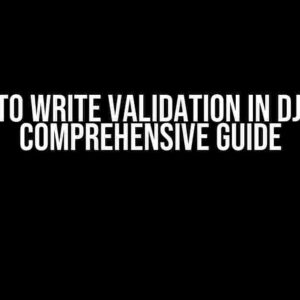The Django Rest Framework (DRF) is a powerful tool for building RESTful APIs in Python. However, like any complex software, it’s not immune to errors. One common error that developers may encounter is the “DRF Given token not valid for any token type” error. In this article, we’ll explore the causes of this error and provide solutions to resolve it.
What Causes the “DRF Given token not valid for any token type” Error?
The “DRF Given token not valid for any token type” error typically occurs when the token provided in the Authorization header is invalid or doesn’t match the expected token type. Here are some common reasons that may lead to this error:
- Invalid Token Format: The token format may not conform to the expected format, leading to validation errors.
- Mismatched Token Type: The token type specified in the Authorization header may not match the token type expected by the API.
- Token Expiration: The token may have expired, making it invalid for authentication.
- Token Blacklisting: The token may have been blacklisted, rendering it invalid for authentication.
How to Resolve the “DRF Given token not valid for any token type” Error?
To resolve the “DRF Given token not valid for any token type” error, follow these steps:
- Verify Token Format: Ensure that the token format conforms to the expected format. Check the API documentation or the token generation logic to ensure that the token is generated correctly.
- Check Token Type: Verify that the token type specified in the Authorization header matches the token type expected by the API. Use tools like Postman or cURL to inspect the request headers and verify the token type.
- Refresh Token: If the token has expired, refresh the token using the refresh token endpoint. This will generate a new token that can be used for authentication.
- Check Token Blacklisting: Verify that the token has not been blacklisted. Check the API documentation or the token blacklisting mechanism to ensure that the token is not blacklisted.
- Debug and Test: Use debugging tools like pdb or print statements to inspect the token validation logic and identify the root cause of the error. Test the API endpoint using different token formats and types to isolate the issue.
Best Practices to Avoid the “DRF Given token not valid for any token type” Error
To avoid the “DRF Given token not valid for any token type” error, follow these best practices:
- Use a Standard Token Format: Use a standard token format like JWT or OAuth to ensure that the token conforms to the expected format.
- Verify Token Type: Verify the token type before sending the request to ensure that it matches the expected token type.
- Handle Token Expiration: Implement token refresh mechanisms to handle token expiration and blacklisting.
- Test Thoroughly: Test the API endpoints thoroughly using different token formats and types to ensure that the token validation logic is robust.
By following these solutions and best practices, you can resolve the “DRF Given token not valid for any token type” error and ensure that your API endpoints are secure and reliable.
Frequently Asked Question
Get the answers to your burning questions about the dreaded “DRF Given token not valid for any token type” error!
What does the “DRF Given token not valid for any token type” error even mean?
This error occurs when the Django Rest Framework (DRF) receives an invalid or malformed token. The token might be expired, or the token type might not be recognized by DRF. Think of it like trying to unlock a door with the wrong key – it just won’t budge!
How do I troubleshoot this error?
First, check the token format and make sure it matches the expected format. Next, verify that the token hasn’t expired or been revoked. If you’re using a token generated by a third-party service, check their documentation for any specific requirements or restrictions. Finally, check your DRF settings to ensure that the token type is properly configured.
Can I use a token from a different DRF project?
Sorry, nope! Tokens are project-specific, so you can’t use a token from a different DRF project. Each project has its own unique token configuration and settings, so trying to use a token from another project would be like trying to fit a square peg into a round hole.
How do I avoid this error in the future?
To avoid this error, always ensure that you’re using the correct token format and type. Regularly review your token configurations and settings to prevent any mismatches. Additionally, implement token blacklisting or revocation mechanisms to prevent attackers from using stolen or compromised tokens.
What if I’m still stuck?
Don’t worry, we’ve all been there! If you’re still struggling, feel free to ask for help on online forums or communities, like the DRF GitHub issues page or Stack Overflow. Provide as much detail as possible about your issue, and someone will likely be able to lend a helping hand.


